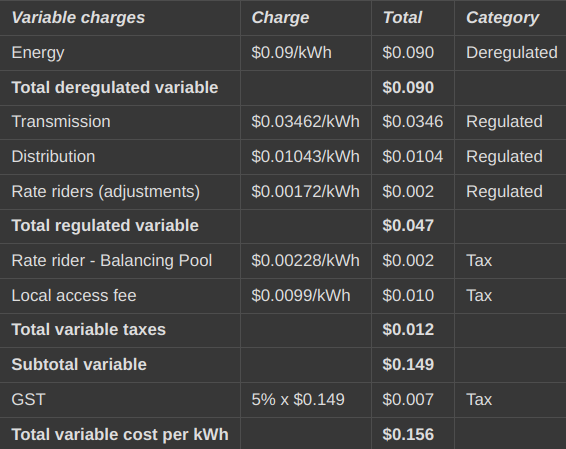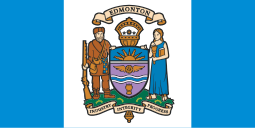Credit: /u/Anabiotic on Reddit
Similar to gas, many people believe their bill is entirely fixed and everything except for the energy charge is unavoidable, even with reduced usage. This is particularly untrue for power, where the fixed charge is significantly smaller than it is for gas. The distinction is important when making decisions on efficiency upgrades and conservation, such as installing solar, purchasing more efficient lighting, or choosing appliances.
For context, the AUC estimates consumers use approximately 600 kWh per month, which I believe is a bit overstated. Usage can vary widely; small apartments may use less than 200 kWh, while large homes with a heavy power draw may use 800 kWh or more. (I typically use around 300-350 kWh in my detached house; my apartment usage was 175-250 kWh). Usage is typically highest in the winter because of electricity usage from increased lighting load and furnace blowers. Houses with air conditioning will often see a second usage peak in the summer. Despite these differences, power usage is typically more stable than gas usage over the year because few in Alberta use electric heat or heat pumps, primarily because it’s cost-prohibitive to operate.
Gas usage is more driven by structural/mechanical components of the house (furnace and water heater efficiency, quality of insulation & air sealing, number and placement of windows, house size, heated garage, etc.) whereas power usage is more linked to consumer behaviour (number, type, and efficiency of appliances, number of people in the home, how often people are home, electronic usage, air conditioning usage, unusually high usage for reasons like doing a lot of laundry, bitcoin mining, grow lamps, having multiple freezers/fridges, and so on).
Your power bill is made up of several components. Here is what these charges are for:
Components of your power bill:

How can you control each component of your bill?
- Deregulated variable: Use less power or change retailers
- Deregulated fixed: Change retailers
- Regulated variable: Use less power
- Regulated fixed: Not much you can do. The actual variable cost of a kWh of power is not just the energy charge. Below I lay it out using an assumed contract price of $0.09/kWh. Your contract may be very different – if you have a legacy contract, it’s likely lower, and if you are on the regulated or variable rate, it’s probably much, much higher because of recent price spikes in the power market.
Variable components
Cost of 1 kWh:

Total variable cost of a kWh that is:
- Regulated - $0.047 (30%)
- Deregulated - $0.090 (57%)
- Tax - $0.020 (13%)
Fixed components
Fixed costs typically vary only by the number of days in the billing period. Below I show a typical 30-day billing period with a retailer who charges $6/month as an admin fee. Retailers’ admin fees may vary from $5-$10/month. - Fixed Cost - Charge - Total - Category
- Admin Fee - $6.00/month - $6.00 - Deregulated
- Fixed Distribution - $0.71445/dayx30 days - $21.43 - Regulated
- Subtotal fixed - - $27.43 -
- GST - 5%x$27.43 - $1.37 - Tax
- Total fixed - - $28.81 -
o maintaining service will cost $28.81 even in the absence of power use.
Total fixed cost that is:
- Regulated - $21.43 (74%)
- Deregulated - $6.00 (21%)
- Tax - $1.37 (5%)
Low bill example
If you have a smaller house/apartment with fewer people in it, are home less often, have fewer appliances, etc., then you might use around 300 kWh a month. Your total bill would be something like $28.81 + $0.156 x 300 kWh = $75.41 (38% fixed, 62% variable).
- $35.37 regulated (47%)
- $32.82 deregulated (43%)
- $7.22 taxes (10%)
High bill example
A larger house with more people, lots of appliance use (lots of laundry, bitcoin mining, lots of lighting/computer use, people working from home, cold winter with the furnace on, etc.), might use 800 kWh/month, with a total bill of $28.81 + 0.156 x 800 kWh = $153.92 (19% fixed, 81% variable).
- $58.85 regulated (38%)
- $78.00 deregulated (51%)
- $17.07 taxes (11%)
Choosing a retailer
Same as gas, there are three types of power rates.
- Fixed rate – You sign up for a term (usually 1-5 years) and are guaranteed a stable rate through the contract term. Most companies allow you to exit at any time without penalty. (You should always verify this by reading the T&Cs, just as you would with any contract).
- Variable rate – Typically this is also for a term of 1-5 years, but like a mortgage, it just guarantees you the “adder” or margin that the retailer will add on to the market price; the base price will fluctuate. For example, your contract might be the market price + $0.01/kWh, which is the retailer’s margin. As with gas, I wouldn’t recommend this in the current market as there is little advantage compared to the regulated rate.
- Regulated rate option (RRO) – This is the default rate if you haven’t signed a contract or your old one expired. It is a similar to a floating rate but the price is set in advance (technically speaking it’s based more on forward rates while the variable rate is based on actual settled prices). As with gas, this is “regulated” as it’s approved by the AUC, and the “adder” is smaller than it is for almost any variable plan you can find so if you want to go variable, the RRO is worth a look.
Same as gas, I would highly recommend a fixed-rate contract for the near- to medium-term. RRO and variable rates have skyrocketed, with August and September being the two highest-priced months ever in the spot market. The forward curve shows prices coming off late next year with the completion of two major projects: the Cascade project and the Genesee repowering project, which will add supply to the market and decrease prices. Additional projects are expected to come on-stream in 2024-25, notably a very large Suncor cogeneration facility.
You can use the UCA’s bill comparison tool to find good rates.
Consumers are currently receiving a flat rebate of $50 per site per month from July - December because of high prices. For lower-usage consumers, this can cover most of the entire bill.
TL;DR:
- The variable cost of a kWh of power is much higher than the energy price alone – other variable costs total ~$0.06/kWh (or $30-40 a month with typical usage)
- Power bills can be massively different depending on your usage and energy price plan
- Wholesale power prices are at all-time highs, which will also result in all-time highs for variable and RRO rates; fixed rate is the way to go for at least the next year or so
- Even if you use no power, you should expect a bill of $25-30; the rest is variable and will change based on usage. More of the typical bill is variable compared to gas, partially because of lower infrastructure costs and partially because the City of Edmonton does not levy a tax on fixed charges for power but does for gas
- Use ucahelps.alberta.ca to find a low-cost retailer for the deregulated part of your bill

